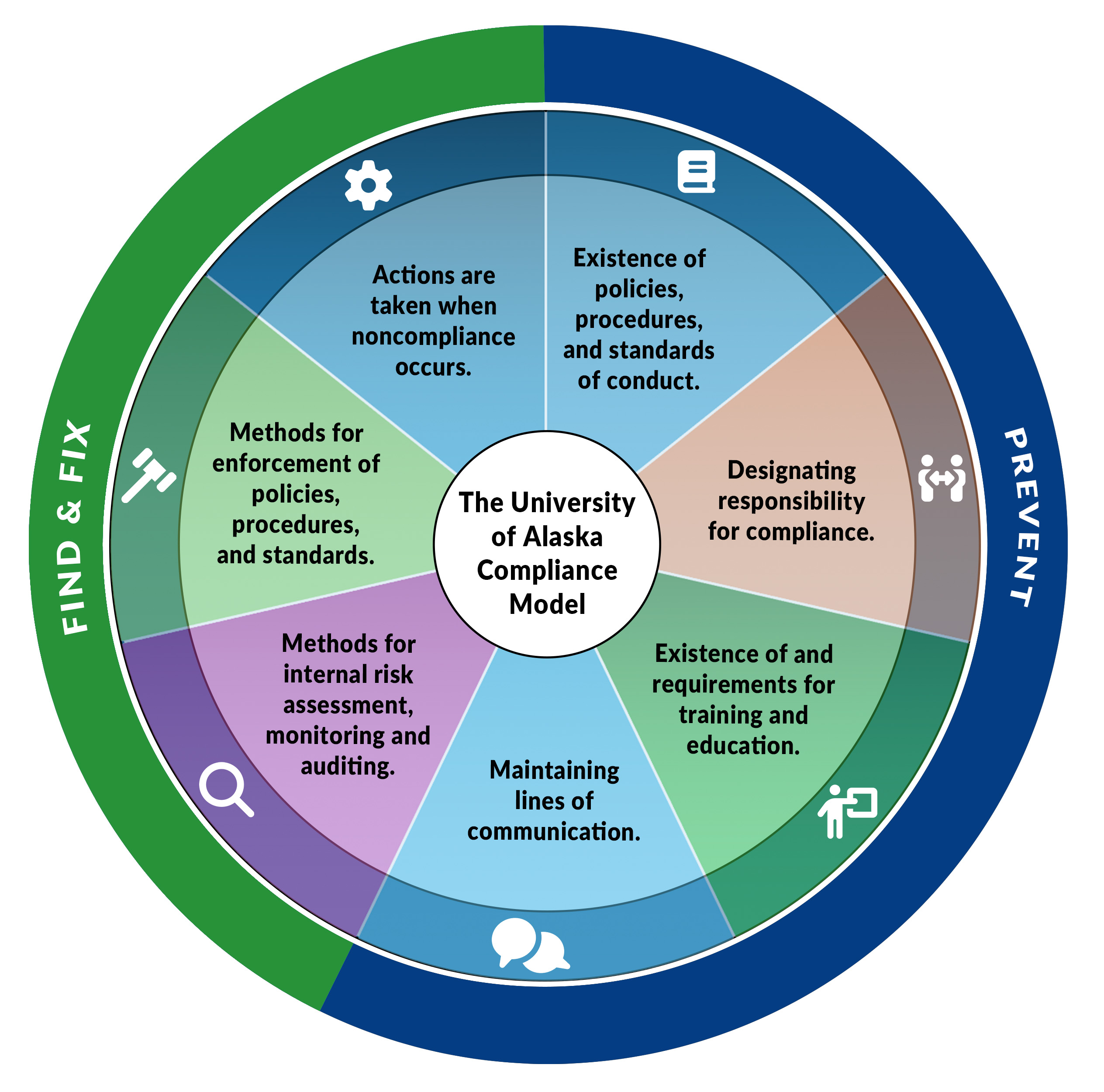Elements of an effective compliance program
Prevent, Find, and Fix: The Primary Purpose of Compliance Programs
All UA employees must actively follow and support current standards and procedures to prevent and detect criminal conduct and facilitate compliance.
These activities are divided into three categories: prevent, find, and fix. This is because the primary purpose of compliance programs is to:
- Prevent compliance issues from occurring in the first place,
- Find compliance issues when they do occur, and
- When found, fix issues quickly and effectively.
Download the Program Guide:

The Compliance Framework
Collaborative compliance efforts provide a healthy and safe environment for students, employees and visitors. A culture of compliance ensures the effective use of university resources and improved operational efficiency.
The cornerstone of a compliance program is to ensure that behavior and decision-making expectations are articulated, clearly communicated and that practical guidance is available and accessible. Actively follow and support current standards and procedures to prevent and detect criminal conduct and facilitate compliance.
The Board of Regents and UA senior leadership will be knowledgeable about the content and operation of the UA’s compliance program. UA’s leadership at all levels will demonstrate a strong commitment to compliant business, research and academic operations at the university. Successfully compliant and ethical university operations depend on the individual commitment of every university community member. As compliance requirements permeate all university programs, institutional compliance depends on a unique level of personal accountability and responsibility at all levels of the university.
Provide appropriate, relevant, and comprehensive education and outreach about compliance requirements. Each institution and appropriate department should take reasonable steps to periodically communicate its standards and procedures by conducting effective training programs and otherwise disseminating information appropriate to individual roles and responsibilities.
University leadership will facilitate and support communication at each university about the university’s compliance program, its purpose and their responsibilities so that UA community members understand and can also fulfill their compliance duties. Reasonable steps will be taken to communicate standards, procedures and roles to members of the institution, including the Board of Regents, to foster a compliance consciousness. Employees are encouraged to report, either directly or anonymously, any concerns and or seek guidance regarding potential or actual misconduct without fear of retaliation.
Continuous monitoring is done by departmental managers to detect their unit’s compliance risk issues and compliance requirement adherence associated with the university’s operations. Reasonable steps will be taken to conduct compliance risk assessments to determine how well UA's business processes fulfill current/changing rules, regulations, or Board of Regents policies.
Ensure there are clear avenues to seek guidance or report violations of policy and relevant laws/regulations. The university will follow appropriate processes, conduct investigations, enforce standards and emphasize non-retaliation.
The university responds appropriately to investigate and address episodes of misconduct and violations of laws, regulations and policies. Steps are taken to prevent further similar conduct from occurring in the future.
The Institutional Compliance Program enables the members of the UA community to better manage the university’s operations and risks for which they are individually and collectively responsible. This is conducted by following a model based on the Federal Requirements of an Effective Compliance and Ethics Program (§8B2.1.) and the U.S. Department of Justice Criminal Division’s Evaluation of Corporate Compliance Programs.
Foundational Documents
Federal Requirements of an Effective Compliance and Ethics Program (§8B2.1.)
https://guidelines.ussc.gov/gl/%C2%A78B2.1
U.S. Department of Justice Criminal Division’s Evaluation of Corporate Compliance
Programs
https://www.justice.gov/criminal-fraud/page/file/937501/download
Regents' Policy & University Regulation
https://www.alaska.edu/bor/policy-regulations/index.php
Higher Education Compliance Alliance Matrix
https://www.higheredcompliance.org/compliance-matrix/
